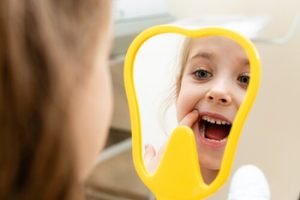Fluoride plays a significant role in helping children build strong teeth during their formative years. It is a familiar part of kids dentistry and is used regularly in treatments designed to support oral health development and prevent future issues. Understanding what fluoride does for young children can guide families toward making informed decisions about long-term dental care.
The Building Blocks of Strong Teeth: Why Fluoride Starts Early
Healthy teeth in childhood provide the foundation for long-term oral wellbeing. Beginning fluoride care early helps form a protective barrier as teeth develop and mature.
How Fluoride Strengthens the Tooth Surface
Fluoride supports the tooth’s hard outer surface by reinforcing mineral content, making enamel more resistant to acid attacks. This layer helps prevent the development of small lesions that can lead to cavities. Over time, this resistance lowers the chance of early tooth decay. Young children benefit most when fluoride is introduced during the stage when baby teeth are erupting. Fluoride exposure through daily brushing and water helps maintain strength.
 The Role of Baby Teeth in Dental Development
The Role of Baby Teeth in Dental Development
Although baby teeth eventually fall out, they are essential in guiding the position of permanent teeth. Damage to baby teeth from decay or poor care can affect the spacing of adult teeth. Fluoride treatments can extend the lifespan of these primary teeth, supporting proper development. Encouraging brushing teeth with fluoride toothpaste from a young age helps set up positive habits. Maintaining baby teeth reduces the risk of more complex dental treatment later.
Why Young Children Receive Special Care
Children under six years of age are particularly vulnerable to tooth decay due to thinner enamel and less effective brushing. Using low fluoride toothpaste in this age group helps balance the benefits of fluoride with the risk of excessive intake. Kids dentistry often includes professional fluoride treatments as part of checkups. These targeted applications help support developing enamel where it is needed most. Dental professionals adjust fluoride concentration based on each child’s age and dental health.
Fluoride in Everyday Life: Where Exposure Happens
Fluoride is more than a treatment. It is present in many aspects of daily life, from the water we drink to the products we use. Learning where fluoride is found can help families make informed choices.
Fluoridated Water and Public Health
In many parts of Australia, fluoridated water is part of the local supply and plays a key role in improving community dental health. Water fluoridation has been a safe and effective way to prevent cavities for decades. Drinking tap water regularly exposes teeth to small, helpful amounts of fluoride. This approach supports both children and adults in controlling tooth decay across all age groups. It also reduces the overall burden of oral health issues in the population.
Everyday Fluoride Products at Home
Parents often encounter fluoride in household items such as fluoridated toothpaste and mouth rinses. These fluoride products are designed for regular use and help maintain enamel strength between dental visits. It is important to monitor children to ensure they do not swallow toothpaste during brushing. Choosing products with the right amount of fluoride for the child’s age is part of safe dental care. Fluoride mouth rinses may also be used under guidance from a dental professional.
Professional Treatments Beyond Home Use
In a dental office, kids may receive fluoride varnishes or topical fluoride treatments to boost enamel protection. These applications are particularly useful for children at higher risk of dental caries or those with early tooth decay. Professional fluoride treatments apply a concentrated amount directly to the tooth surface. This method is carefully controlled to avoid excess fluoride while still offering effective protection. These treatments are often included as part of a child’s regular dental checkup.
Finding the Right Balance: Fluoride Use and Safety
Fluoride is safe when used appropriately, but understanding limits is key. Too much fluoride can cause effects just as too little might leave teeth unprotected. Balancing intake ensures the desired outcome.
Monitoring Fluoride Levels at Home
The amount of fluoride children consume from different sources needs to be managed carefully. Parents should be aware of the fluoride levels in drinking water, toothpaste, and any supplements their children take. Knowing how much fluoride a child receives helps prevent unwanted effects. A dental professional can help determine whether fluoride supplements or fluoride tablets are appropriate. Each child’s needs may differ based on age, health, and location.
Recognising and Avoiding Excess Fluoride
Consuming too much fluoride over time can lead to dental fluorosis, a cosmetic condition affecting the appearance of enamel. This typically happens when young children swallow toothpaste or use products intended for adults. Limiting fluoride intake to age-appropriate levels helps avoid this issue. Dental care instructions from your dentist often include guidance on appropriate product use. Monitoring helps maintain the balance between protection and overexposure.
 Why Fluoride Safe Practices Matter
Why Fluoride Safe Practices Matter
Even though fluoride is a naturally occurring mineral, its use must be tailored to individual needs. Dental professionals use tools such as dietary reference intakes and oral health assessments to determine safe use. This ensures children get the benefits of fluoride without crossing into high doses. Education around safe use helps families understand how fluoride works and when to adjust routines. Ultimately, these practices lead to stronger teeth and fewer dental visits.
Supporting Prevention at Every Stage
Children and parents alike benefit from a proactive approach to prevention. Fluoride is one part of a larger effort to reduce risk and build habits that last.
Creating a Routine That Protects Teeth
Daily brushing with the right fluoride concentration is one of the most effective ways to prevent tooth decay. Encouraging children to brush twice a day and rinse when appropriate helps remove plaque bacteria. This practice reduces the chance of cavities and contributes to overall oral health. When fluoride toothpaste is used correctly, it works together with brushing to maintain enamel strength. Starting this routine early is especially important for young children.
Partnering with a Dental Professional
Regular visits to a dental office give children access to ongoing care tailored to their needs. A dentist may recommend specific fluoride treatments depending on the child’s risk of dental decay. Building a relationship with a trusted dental professional helps track growth and respond to early signs of trouble. During appointments, parents receive guidance on fluoride exposure, proper brushing, and dietary choices. This partnership supports effective, personalised dental care.
Using Prevention to Avoid Treatment Later
Focusing on prevention can limit the need for more complex procedures as children grow. Protecting tooth enamel in the early years helps reduce dental decay and the complications that follow. Topical fluoride treatments, regular exams, and fluoride mouth rinses are less invasive than fillings or extractions. Making prevention a part of everyday life can protect both primary and permanent teeth. These simple steps can lead to fewer problems and more confident smiles.
Understanding Fluoride’s Wider Impact
Fluoride’s role in oral health reaches beyond the individual. Its effect on public health, dental habits, and community wellbeing makes it an essential part of modern care.
Supporting Both Children and Adults
Although much focus is placed on fluoride for children, adults benefit from its protective effects as well. Drinking fluoridated water and using the right fluoride toothpaste help preserve natural teeth through every stage of life. Both children and adults need support in managing enamel erosion, decay, and plaque buildup. Including the whole family in fluoride care creates a stronger oral health foundation. Consistency across all ages helps reinforce the habit.
Public Health Strategies That Work
Water fluoridation remains one of the most widely supported public health initiatives in dentistry. It ensures equitable access to fluoride regardless of income or geography. As a result, many children grow up with fewer cavities and stronger enamel. Governments and dental associations continue to support this method based on systematic review and research. The long term outcomes highlight how fluoride works not only for individuals but for communities.
 Avoiding Misunderstandings About Fluoride
Avoiding Misunderstandings About Fluoride
Concerns about too much fluoride or how to remove fluoride from daily routines often stem from misinformation. Fluoride is regulated closely to ensure it is used safely. Understanding the purpose and proper use of fluoride products helps clarify its value in dental care. Accurate information from a dental professional is key when making decisions about fluoride intake. Knowledge builds confidence and empowers families to protect their smiles.
Ready to Protect Your Child’s Smile with Fluoride?
Knowing what fluoride does in the context of kids dentistry helps make its value clear. It supports enamel strength, reduces the risk of dental caries, and contributes to long-term oral health. When used with care and guidance, fluoride offers benefits that span from baby teeth to adult smiles. Whether through brushing, drinking tap water, or receiving professional fluoride treatments, fluoride remains an important tool in protecting teeth at every stage of growth. With support from parents and guidance from your dental professional, children can build the foundation for healthy, confident smiles that last a lifetime. To learn more or book a fluoride treatment for your child, visit our clinic today. Please call us on (02) 9969 3982 to schedule your appointment.
References
https://www.medicalnewstoday.com/articles/327168
https://jada.ada.org/article/S0002-8177(14)62166-8/fulltext


 The Role of Baby Teeth in Dental Development
The Role of Baby Teeth in Dental Development Why Fluoride Safe Practices Matter
Why Fluoride Safe Practices Matter Avoiding Misunderstandings About Fluoride
Avoiding Misunderstandings About Fluoride




